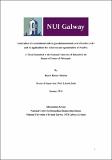| dc.contributor.advisor | Joshi, Lokesh | |
| dc.contributor.author | Sharma, Rajesh Kumar | |
| dc.date.accessioned | 2016-05-12T12:45:51Z | |
| dc.date.issued | 2016-05-12 | |
| dc.identifier.uri | http://hdl.handle.net/10379/5777 | |
| dc.description.abstract | Sialic acids are a family of 9 carbon α-keto acid monosaccharides. Owing to their terminal position on glycans, sialic acids are involved in cell adhesion and recognition events, host pathogen interactions, immune regulation and in disease processes such as cancer progression. Sialic acids are highly diverse with more than 50 different forms reported to date. The two predominant forms of sialic acid expressed in the mammals are the N-acetylneuraminic acid (Neu5Ac) and N-glycolylneuraminic acid (Neu5Gc). Though humans can no longer synthesise Neu5Gc due to an evolutionary mutation in the enzyme responsible (CMAH), the presence of this non-human glycan has been frequently reported distributed on a number of human tissues, both healthy and malignant. Neu5Gc has also been reported as a contaminant in biopharmaceutical preparations, produced in mammalian cell systems, compromising their safety and efficacy. To date, no monoclonal antibody has been reported against Neu5Gc. Neu5Gc recognition molecules would have applications in detection and quantitation of Neu5Gc in clinical diagnosis (e.g. cancer screening) and in quality control for biopharmaceutical manufacturing. The research performed within this thesis was directed towards the construction and characterisation of anti-Neu5Gc antibody fragments for application in the detection and quantitation of Neu5Gc.
Derived from an immunised chicken, short and long-linker single chain fragment variable (scFv) phage display library were constructed and biopanned against the Neu5Gc. A panel of anti-Neu5Gc scFvs were identified and assessed for their binding specificity and affinity to Neu5Gc. Among the panel of anti-Neu5Gc scFvs, short-linker scFv-SL1A1, demonstrated the highest sensitivity for binding to Neu5Gc and was selected as lead candidate for further characterisation and assay development. By competitive ELISA, developed for detection and quantitation of Neu5Gc, scFv-SL1A1 detected Neu5Gc with an IC50 of 514 nM. The scFv-SL1A1 demonstrated high specificity for Neu5Gc in free as well as protein bound form. Further assessment of scFv on western blot and surface plasmon resonance supported the demonstration of Neu5Gc specificity. In western blotting platform, scFv-SL1A1 detected the presence of Neu5Gc on clinical samples and on commercial biopharmaceutical preparations. Investigations to assess the suitability of scFv-SL1A1 for immunohistochemistry applications were performed. This thesis research reports the generation and characterisation of the first recombinant monoclonal anti-Neu5Gc scFv fragment. | en_IE |
| dc.rights | Attribution-NonCommercial-NoDerivs 3.0 Ireland | |
| dc.rights.uri | https://creativecommons.org/licenses/by-nc-nd/3.0/ie/ | |
| dc.subject | Anti-Neu5Gc scFv, Anti-sialic acid molecules, N-glycolylneuraminic acid, N-acetylneuraminic acid, Phage display, Glycan recognition molecules, Neu5Gc quantitation. | en_IE |
| dc.subject | Anti-Neu5Gc scFv | en_IE |
| dc.subject | Anti-sialic acid molecules | en_IE |
| dc.subject | N-glycolylneuraminic acid | en_IE |
| dc.subject | N-acetylneuraminic acid | en_IE |
| dc.subject | Phage display | en_IE |
| dc.subject | Glycan recognition molecules | en_IE |
| dc.subject | Neu5Gc quantitation | en_IE |
| dc.subject | Natural science | en_IE |
| dc.subject | Glycoscience | en_IE |
| dc.title | Generation of recombinant anti-N-glycolylneuraminic acid (Neu5Gc) scFv and its applications for detection and quantitation of Neu5Gc | en_IE |
| dc.type | Thesis | en_IE |
| dc.contributor.funder | SFI, GlycoHIT | en_IE |
| dc.local.note | Sialic acid is a group of sugars that coat cell surface of cells. Human body cannot make a specific type of sialic called as Neu5Gc. However, in diseases like cancer Neu5Gc is somehow found on cancer cells. Even drugs, that are produced commercially can also contain Neu5Gc, which can make drugs unsafe for human use. The aim of this research was to develop antibody molecules that can detect this sugar in cancer and in drugs for human use. These molecules can then be used for early detection of cancer and for checking quality of the therapeutic drugs. | en_IE |
| dc.description.embargo | 2018-05-11 | |
| dc.local.final | Yes | en_IE |
| nui.item.downloads | 898 | |


